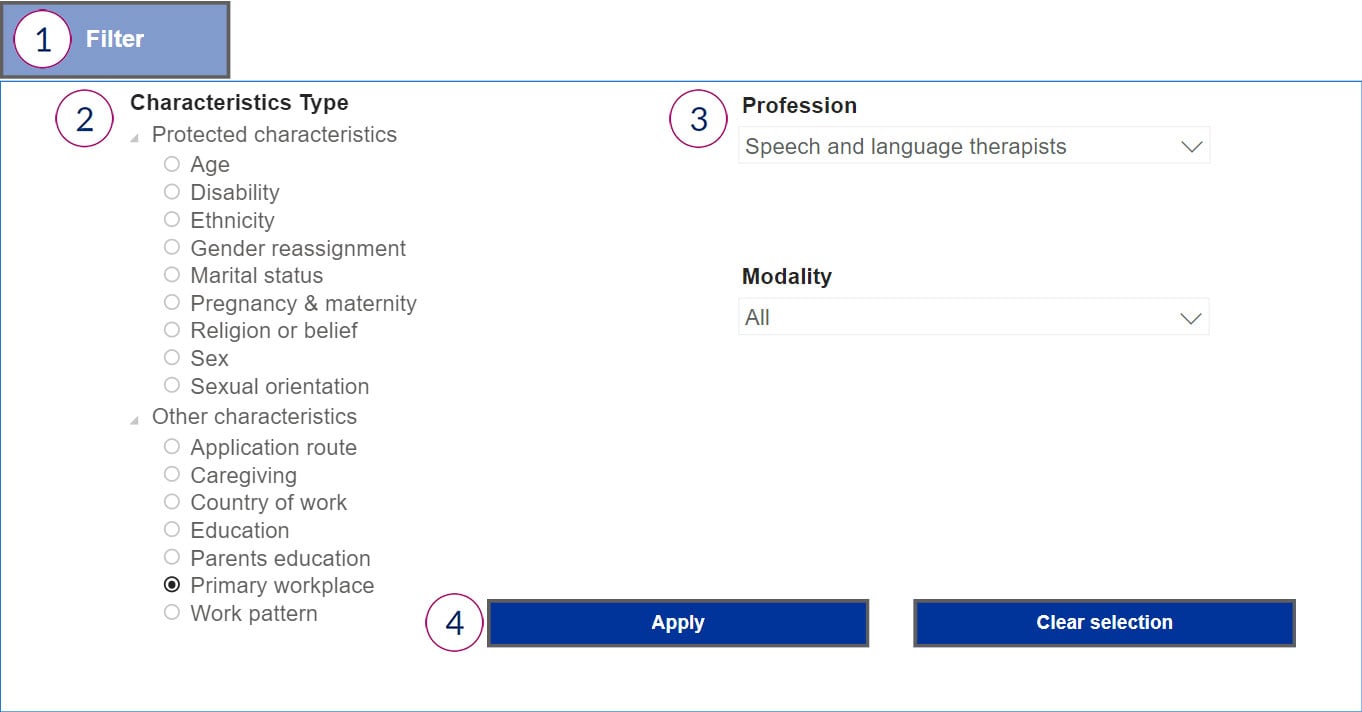User guide
The 'Diversity dashboard' shows key equality, diversity & inclusion (EDI) information held by the HCPC with regards to different characteristics of our registrants.
The data can be filtered by the 15 professions (and associated modalities) that we regulate.
-
- Click 'Filter' to display filter options
- Select a 'Characteristic type'
- Select a 'Profession' (and 'Modality' if relevant)
- Click 'Apply' to close filter options and view data

-
Protected characteristics
The nine protected charateristics of the Equality Act 2010: Age, disability, ethnicity, gender reassignment, marriage and civil partnership, pregnancy and maternity, religion or belief, sex, sexual orientation.Registrants
An active registrant on the HCPC register at the time of the analysis.Respondents
Registrants who provided other protected characteristic EDI data via the portal or survey.Count
Number of registrants (age & sex) or respondents (other protected characteristics).Not recorded
Total number of registrants/respondents for whom this information is not held. For respondents these are due to data collection system errors and only includes those who have attempted to give this information.Recorded
Total number of registrants/respondents for whom this information is held.All professions
Age & Sex: All active registrants on the HCPC register, regardless of profession.Other protected characterictics: All respondents of EDI regardless of profession.
-
All questions have a "prefer not to say" option which is included in the tables. Prefer not to say is a valid response and is different in meaning to not recorded.Charactersic
Question asked
Age "What was your date of birth"
(This was used to calculate current age at the point of production of this factsheet).Disability "Do you consider yourself to have a disability or to be a disabled person?"
In the UK, a disability is defined as "a physical or mental impairment which has a substantial and long-term* adverse effect on a person's ability to carry out normal day-to-day activities" You may have none, one, or more conditions that you believe are covered by this definition. Please answer how you feel this definiton applies to you. (*long-term means that the impact has lasted, or is expected to last, for 12 months or more)Ethnicity "Which of the following best describes your ethnic origin? Ethnicity is defined as including colour, ethnic or national origin, or nationality. Please choose whichever answer best reflects how you think of yourself." Gender reassignment "Is the gender you identify with the same as your sex registered at birth?"
Your gender identity may be the same as your assigned sex, but it may be different. You may identify as the opposite gender to your assigned sex, you may identify with neither, or with a self-described gender identity.Marriage and civil partnership "What is your legal marital or registered civil partnership status?" Pregnancy and maternity "Do you consider your self to fall under the protected characteristic of 'pregnacy & maternity', as per the Equality Act 2010? 'Pregnancy' refers to the condition of being pregnant or expecting a baby, and 'maternity' refers to the period of 26 weeks after birth. The Equality Act 2010 protections also cover a someone who has had a miscarriage." Religion or belief "What is your religion or strongly held belief, if any?" Sex "What is your Sex?"
This is the sex you were assigned at birth and we asked you to provide this information when you registered with the HCPC. For births registered in the UK, this will either be male or female. However, some other countries may include 'intersex' as an option. We also ask if your gender identity is different from the sex you were assigned at birth. Your gender identity may be the same as your assigned sex, but it may be different. You may identify as the opposite gender to your assigned sex, you may identify with neither, or with a self-described gender identity.Sexual orientation "Which of the following best describes your sexual orientation?"
Related dashboards
Related content
Explore our data hub
Find interactive dashboards and key data summaries:




